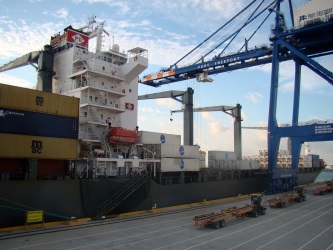
| November 4, 2014 | |
Connectivity: Canaveral, Longview, Port Freeport (TX), Metro Vancouver
![]() Print this Article | Send to Colleague
Print this Article | Send to Colleague
The Canaveral Port Authority which currently has no direct rail service, plans to build and operate an 11-mile extension that would link the port to the Florida East Coast Railway via an existing NASA rail line at Kennedy Space Center. The Port of Longview is launching a $10 million Industrial Rail Corridor expansion project aimed at improving cargo-movement efficiency for existing and future customers. Port Freeport celebrated two milestones on October 23 with the inaugural call of a Mediterranean Shipping Co. (MSC) service and the first use of the port’s recently purchased Post Panamax ship-to-shore cranes. The newly completed Roberts Bank Causeway Overpass rail/road grade separation project will improve the fluidity and safety of container traffic flows to and from Port Metro Vancouver’s Deltaport Container Terminal and boost its throughput capacity by up 200,000 TEUs annually.
Port Canaveral’s Plans for Rail Service
The Canaveral Port Authority plans to request authority from the federal Surface Transportation Board to build and operate an 11-mile extension of new rail from the port to the 17 miles of existing NASA rail line at Kennedy Space Center (KSC), which links to Florida East Coast Railway. This direct access to freight rail service would help facilitate cargo expansion at Port Canaveral.
The port currently does not have direct rail service at its facilities.
Under the current proposal, the new rail line would begin near the port’s north cargo area, extend west across the Banana River, enter KSC on Merritt Island south of Kars Park, and then turn north through KSC grounds where it would connect with KSC’s existing rail line.
The port authority has scheduled public meetings, where stakeholders, including residents, governmental agencies, environmental groups, and the maritime industry will be able to provide verbal or written comments on the proposal
The Surface Transportation Board’s Notice of Intent to prepare an Environmental Impact Statement can be found on the board’s website, www.stb.dot.gov.
Port of Longview To Expand Industrial Rail Corridor
The Port of Longview is launching a $10 million Industrial Rail Corridor expansion project aimed at increasing cargo-movement efficiency for existing and future customers.
"This rail project strategically positions us for growth in the big picture," said Port CEO Geir-Eilif Kalhagen. "It will make a huge difference to our customers who rely on rail service."
In 2016, the port plans to add one more track and two 7,000-foot sidings to the Industrial Rail Corridor’s existing two tracks. The additional capacity will allow three simultaneous train movements as well as storage of two unit trains on the side tracks. The port will build the project in phases using local trade union labor unions.
The Industrial Rail Corridor connects to BNSF Railway’s main line, which is also used by Union Pacific Railroad.
The current rail corridor, which was completed in 2005 at a cost of $21 million, allows unit trains to enter and leave the port with blocking roadways or interfering with vehicular traffic. According to the port, the corridor was of critical importance in the successful effort that led to the building of a $230 million export grain terminal on its premises.
Mediterranean Shipping Company Arrives at Port Freeport (TX)

Port Freeport’s new container cranes at work.
Photo/Port Freeport
Port Freeport celebrated two milestones on October 23 with the inaugural call of a Mediterranean Shipping Co. (MSC) service and the first use of the port’s recently purchased Post Panamax ship-to-shore cranes. The port says the new cranes helped it secure MSC’s new "Banana Express" service and retain Chiquita Brands International, which is in a vessel sharing agreement with MSC.
"This is a very exciting time for the port," said Port Freeport Executive Port Director/CEO Glenn Carlson. "We are expecting a sizeable increase in volumes from all of the petrochemical companies in the Freeport region. These companies will benefit from reduced inland expense by utilizing Port Freeport and will be able to further reduce these logistical costs by utilizing the "Heavy Lift" corridor," explained Carlson.
The "Banana Express" will initially deploy five 2,500 TEU vessels servicing the Caribbean market and provide access to new markets via MSC’s global market.
Metro Vancouver: Roberts Bank Causeway Overpass Completion Boosts Container Throughput Capacity
An October 24 ceremony celebrated the completion of the Roberts Bank Causeway Overpass. The two-lane overpass provides grade separation between rail tracks and the Roberts Bank Causeway access road adjacent to the Port Metro Vancouver’s Deltaport Container Terminal. Its purpose is to improve safety for transportation operators involved in the movement of goods for international trade, facilitate the flow of in- and outbound containers, and add capacity at the terminal.
The overpass is an element of the Deltaport Terminal, Road and Rail Improvement Project, which is a near-term plan developed by the port to reduce delays and inefficiencies in rail and truck operations and to increase cargo-handling capacity at Deltaport.
It plays essential role in Canada’s Asia-Pacific trade by improving the efficiency of the Roberts Bank Rail Corridor, which serves the Deltaport Container Terminal.
The total cost of this project was $44.7 million project was financed by contributions of C$19.9 million from the Canadian federal government’s Asia-Pacific Gateway and Corridor Transportation Infrastructure Fund and C$24.8 million from the port authority.
Construction began in early 2013 and was completed on time and within budget.
Deltaport Container Terminal is the largest container terminal in Canada, handling approximately 50 percent of the containerized cargo that moves through Canada’s West Coast.
According to the port and the government, the improvement will boost Deltaport’s throughput capacity by an estimated 150,000 to 200,000 TEUs annually.
